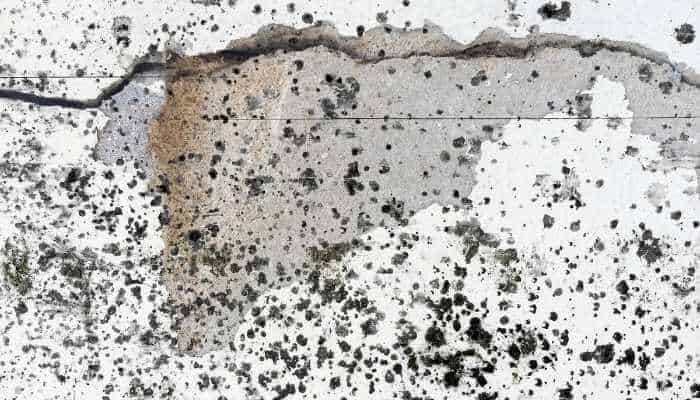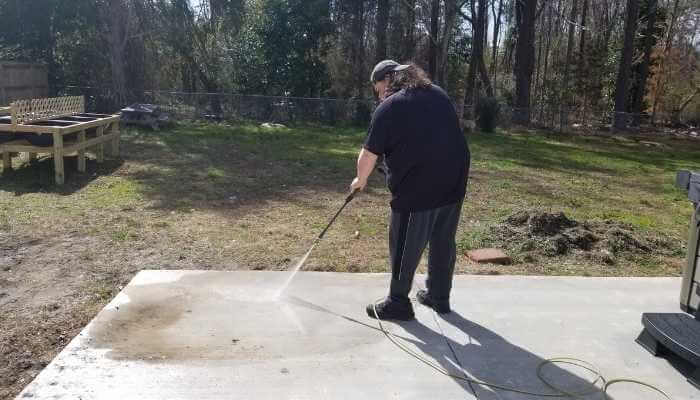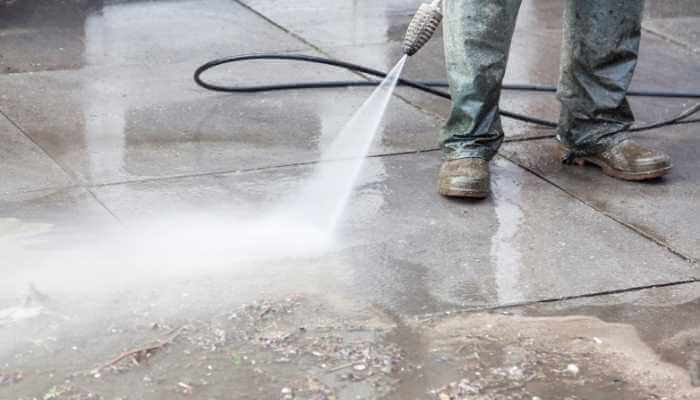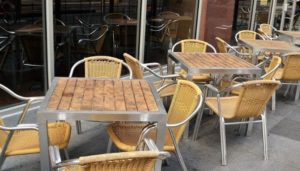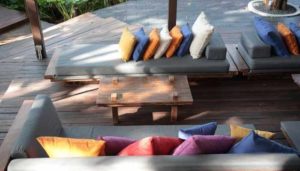
How many times have you asked this question? As a homeowner, it can be pretty often. And you have to figure out the answer to that question before you can decide how to remove the stains.
The black spots and marks that wind up on your concrete through the years can be caused by any number of things, including de-icer, overabundant water, trowel burn at installation, detritus from vegetation, or walnuts and their husks. Anything left to sit on concrete can make a stain.
So, how do we treat them? First, you clean up any loose dirt and detritus around the area you need to clean. Keep reading; I’ll tell you how to treat and hopefully eliminate each stain.
Calcium Chloride in De-Icer
Did you use a calcium chloride de-icer on your concrete? Because if you did, it might have left black spots or other discoloration behind.
Calcium chloride is very good for removing snow and ice. Unfortunately, it’s also awful for your concrete.
That’s because it can penetrate the concrete’s pores and interact with the minerals in the mix. The salts can also attach to oils that seep into your concrete. This can weaken the concrete and change its color – it’s particularly known to cause black spots. It’s essential to wash de-icing salts off after you use them, as soon as it’s safe and warm enough that the rinse water won’t freeze.
Water Stains
Water can also cause dark spots – especially if you have a leaky faucet or a gutter system that opens onto concrete. When water has a high mineral content, it carries a lot of dirt or iron, which can cause staining and even dark discoloration on concrete.
Water carries all kinds of molecules and particles – salts, chemicals, oils, and other particles.
As the concrete absorbs the water, all those get deposited inside the concrete. They can build up to discolor your concrete over time, resulting in black spots. So, what can be done about it?
Using some sort of acidic rinse along with pressure washing can do the trick. Here’s a good recipe:
- 1cup ammonia
- ½ gallon warm water in a bucket
- A soft-bristled brush or sponge
Stir the ammonia into the warm water with your brush or sponge. Using that brush or sponge, apply the mixture onto the black stain and let it sit for 5 minutes. Ammonia is a decent strength base, so wear gloves when you handle it.
Then, scrub the stain. This will remove it in layers, so you may have to repeat the process. Once the stain is gone, wet a towel with warm, clean water and use it to wipe the area free of the solution you used. Let it air dry.
You may think, “but you said ammonia is a base, so why does this work if you’re supposed to use an acid?” It’s because when ammonia comes into contact with water, a molecular reaction makes the water act as a weak acid. Isn’t science fun?
You can also use mineral spirits or paint thinner. Saturate the stain with the liquid and then cover the stain with something absorbent like cornstarch, baking soda, cornmeal, or cat litter. Let this sit overnight, and then sweep it all up. Use a warm, wet towel to wipe the area and let it air dry. This method is also helpful for oil stains.
Trowel Burn
If you hire a professional to pour your concrete, they are less likely to create a situation that will leave black spots in your slab. However, there’s always a chance that discoloration on new concrete will happen.
It could be a bad mixture, there could have been too much water used, not enough water used, curing might not have worked properly, or someone overworked the surface to try and get it smooth, causing trowel-burn.
Any of these situations can cause discoloration and black spots to appear in new concrete. Unfortunately, you cannot do much about this particular brand of discoloration.
If you used a contractor and now have an unexplained stain? You should get in touch with them to let them know about it. It may be their responsibility to deal with it.
How can they deal with it, and if you accidentally did this to your concrete, how can you fix it?
If you acid-wash the slab (which is quite a long process), and that doesn’t seem to be taking out the discoloration, there are still other options. You can use an acid stain or an acrylic sealer to darken the surface and leave a consistent finish across your concrete.
Or, if you’re up for it, you can apply a cement or concrete overlay over the entire surface to cover the blemishes on the original surface.
Walnut Stains
You can get various stains from tree leaves, branches, seeds, fruits, and nuts. Black spots are very common when you have specific nuts left on your patio for long periods. Let’s take the walnut as an example. It’s so easy for black walnuts to stain items that you can literally make a homemade version of wood stain from them.
So, how do you remove walnut stains from concrete? The tried and true solution uses granular chlorine in a mixture strong enough to remove the stains. Remember that chlorine can harm your skin, eyes, and lungs, so wear protective gear.
Here’s what you’ll need:
- Granular Chlorine (yes, the kind used in pools)
- ⅔ cup of soft soap flakes, aka Borax or FOCA
- 4 tablespoons Dawn Liquid Dishwashing Detergent
- A mop bucket of hot water
- A spray bottle of water
First, dampen the stains with water, not enough to puddle, but enough to be damp. Then, sprinkle the granules over the area. Using a spray bottle, mist the granules without over-watering them. This needs to sit on the stains for five minutes.
In the meantime, you need to fill a mop bucket with hot water, 4 tablespoons of Dawn dishwashing detergent, and the Borax. Once the five minutes are up, use the mixture in the mop bucket to scrub the stains vigorously using a nylon brush. Rinse and repeat until the stain is gone or you give up.
Another method you could try is using a potent mixture of chlorine bleach to try and coax the stain to leave. You’ll need 1 part bleach to 2 parts hot water in a bucket. Pour that mixture over the concrete and let it sit for 30 minutes.
Then, scrub the area with a stiff brush and rinse the area with a high-pressure hose or a pressure washer. You may need to repeat this until the stain is broken up and rinsed away.
I recommend getting the LandHope Hard Bristle Deck Broom to help you scrub without getting on your hands and knees.
If this doesn’t work, consider Trisodium Phosphate (TSP) as your last resort. This is a really caustic chemical and can cause a lot of damage to your skin, eyes, and lungs if you don’t take proper precautions.
The standard way to use TSP for concrete cleaning is:
- 1cup TSP
- 1-gallon hot water
Pour that mixture over the concrete and let it sit for 15-20 minutes. Scrub the area, then rinse the area thoroughly with clean water.
TSP has been banned in some U.S. states, so check with your local government before purchasing any or look for an environmentally-safe TSP alternative that can provide the same cleaning action without harmful effects.
If you decide to use chemicals instead of homemade cleaners, follow the manufacturer’s guidelines on safety and usage.
What’s Important…
In the end, there could be any number of reasons that you have black spots or blemishes on your concrete. The important thing to do is identify what caused the discoloration. Why? Because each kind of stain needs a different type of cleansing.
You’ll waste time and money if you use the wrong cleaning ritual on your concrete. You’ll possibly make things worse. Want to try something else to clean your mysterious spots on the concrete? Or do you have a different kind of stain on your concrete to worry about? Check out my article that covers The Best Ways to Clean your Concrete Patio.
